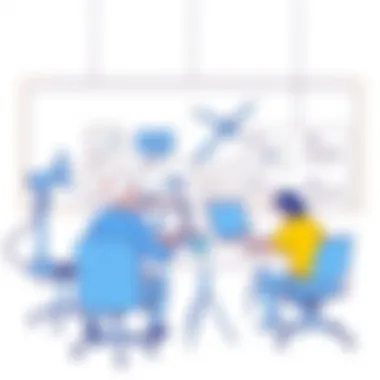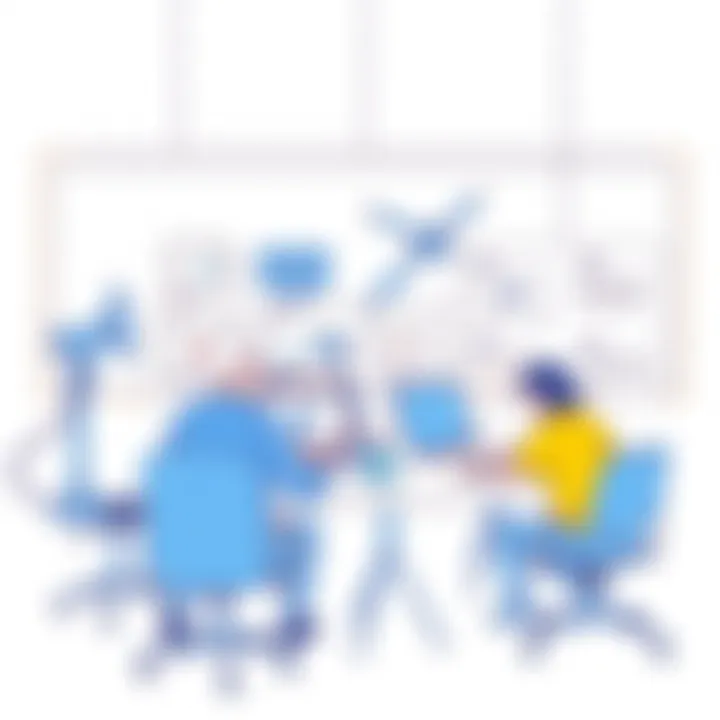Essential Wireframing Tips for Successful App Development


App Overview
When diving into the world of app development, wireframing stands as a foundational step that shapes the design and functionality of the final product. It's like sketching out a blueprint before building a house. This section introduces what a wireframe is, its significance in app development, and the key components that create a well-rounded user experience.
Prelude to Wireframing and Its Main Features
Wireframing is not just about drawing some boxes on a page; it's about visualizing the structure of your app, enabling you to communicate ideas, features, and pathways before they become concrete. Considering the multitude of devices and platforms out there, a wireframe provides a scalable guide for how your content fits within various screens.
The main features of wireframing typically consist of:
- Layout Design: Determines where different elements are placed within the app’s interface.
- Interactive Elements: Including buttons, inputs, and links, wireframes help visualize how users interact with your app.
- Navigation Structure: Outlines how users will move through the app, ensuring a seamless experience.
Key Functionalities and Benefits of the App
Understanding the core functionalities that your app needs can be a game-changer. Each element added into the wireframe should serve a purpose. Here are some benefits associated with wireframing in app development:
- Enhances User Experience: A well-structured wireframe focuses on user pathways, ensuring they can navigate intuitively.
- Facilitates Communication: Wireframes help bridge the gap between developers, designers, and stakeholders, making it easier to convey ideas.
- Saves Time and Resources: Identifying flaws and areas for improvement at the wireframing stage can save you from costly revisions later on.
"Wireframing is the bridge between ideas and execution; it helps in catching errors before they snowball into larger problems."
Step-by-Step Walkthrough
To truly understand the art of wireframing, it's crucial to go through the steps of creating an effective wireframe. Here’s a general approach that can aid in your development process:
- Define the Purpose: Understand what the wireframe is intended to achieve.
- Identify Key Features: List the functionalities and elements that need to be included.
- Sketch the Layout: Start with low-fidelity wireframes. Use pen and paper or digital tools like Balsamiq or Sketch.
- Add Interactivity: For high-fidelity wireframes, introduce clickable elements using tools like Adobe XD or Figma.
Tips and Tricks
Here are a few expert strategies that enhance the wireframing process:
- Use Grids: Implementing a grid system can lend structure and rhythm to the layout.
- Keep It Simple: Overcomplicating can lead to confusion. Stick to essentials during the wireframe stage.
- Iterate Quickly: Don’t strive for perfection in your first draft. Instead, focus on getting ideas down and refining them as you progress.
Common Issues and Troubleshooting
Even seasoned developers may face hurdles in the wireframing process. Some common problems include misunderstandings around user needs and a misalignment of vision between team members. Here are some potential solutions:
- User Feedback: Conduct interviews or surveys to ensure your wireframe aligns with real user needs.
- Regular Check-ins: Establishing a communication framework ensures all stakeholders are on the same page to tackle misalignment early on.
Further Resources
For a deeper dive into wireframing and app development, consider exploring the following resources:
Understanding Wireframing in App Development
Wireframing is an essential step in the app development process. It acts as the blueprint, outlining the structure, functionality, and user interactions within an application. Understanding this concept can significantly elevate the quality of the final product, making it particularly critical for app developers, designers, and even tech-savvy users who want to brush up on their skills.
When creating wireframes, you essentially sketch the key components of your app, showcasing layouts and flow without delving into graphical elements or colors. This allows you to concentrate on what really matters – the user experience. The strength of wireframing lies in its ability to visualize the app at an early stage, catching potential usability issues before any coding starts, thus saving time and resources in the long run.
Additionally, wireframes serve as a communication tool among team members. Developers, designers, and stakeholders can come together and discuss the vision for the app, fostering collaboration and ensuring everyone is aligned on the objectives. By addressing design concepts at this early stage, the likelihood of miscommunication decreases.
Defining Wireframing
Wireframing can be defined as a visual representation of the app’s skeletal framework. Think of it as a rough sketch that focuses on the placement of elements such as buttons, menus, and text blocks. The primary goal here is to lay down the core features and functionality, to gather feedback and iterate before the design evolves into high-fidelity mock-ups or the final product.
In more technical terms, wireframes can be categorized into low-fidelity and high-fidelity versions, each serving different purposes throughout the development cycle. Low-fidelity wireframes are basic, often hand-drawn, whereas high-fidelity variants incorporate more detailed elements, including precise spacing and interactive components, preparing the app for a user testing phase.
Importance of Wireframing
The importance of wireframing in app development cannot be overstated. Firstly, it streamlines the overall design process. With wireframes, you can quickly iterate different concepts and layouts without the burden of getting into specifics too soon. This flexibility helps in promoting strategic thinking among the development team, allowing considerations of various functionalities and user flows.
Moreover, wireframes are crucial for user testing. They provide a tangible layout that users can interact with, allowing developers to gather feedback based on real user experiences. This validation makes it easier to identify pain points or confusing elements that require adjustments before the app gets to the coding stage.
Wireframing helps visualize the user experience, making adjustments before any coding begins, saving both time and resources.
Lastly, utilizing wireframing in your workflow can result in better final products. With a solid foundation laid out and potential flaws addressed early on, the final app is likely to meet user needs more effectively, aligning with the objective of creating user-centered applications. In short, wireframing doesn’t just make your life easier – it enhances both the development process and the user experience.
Types of Wireframes
Wireframing is an essential step in app development, and understanding the different types of wireframes can drastically affect the design process. It helps in visualizing the layout and understanding user interaction before diving into actual development. By grasping these concepts, teams can save time and resources, ensuring that the final product meets user expectations while aligning with business goals. In this section, we will explore the two major types of wireframes: low-fidelity and high-fidelity, dissecting their characteristics and the scenarios in which they're best utilized.
Low-Fidelity Wireframes
Characteristics
Low-fidelity wireframes are often the first step in the design process. They tend to be simple sketches rather than detailed designs, focusing on layout and basic functionality without delving into visual aesthetics. Their key characteristic is their simplicity. This simplicity makes them a crowd favorite among designers and developers alike, as they allow for rapid iteration without the burden of perfection.
One unique feature of low-fidelity wireframes is their use of basic shapes to represent various interface elements. For instance, a rectangle might stand in for a button, while lines may denote text areas. Such representations help in visualizing the overall flow and structure of the app. The advantages are clear: they allow for feedback early in the process and facilitate discussions among team members without getting bogged down in fine details. However, the downside lies in the risk of oversimplifying features, potentially leading to misunderstandings about functionality.
When to Use
Low-fidelity wireframes are ideally suited for initial stages of development, where the focus is on brainstorming and gathering input. Think of them as the rough drafts of a writer's work—key ideas are laid out and flexible, ready for further analysis. When kicking off a project, it's beneficial to use low-fidelity wireframes for user research and stakeholder presentations. They encourage engagement and dialogue as stakeholders can easily comment on flow and placement.
However, one must be cautious. In a situation where detail is needed, solely relying on low-fidelity wireframes may result in stakeholders dismissing the designs as inadequate. Therefore, they serve best as a preliminary tool, helping to frame discussions rather than presenting a final solution.


High-Fidelity Wireframes
Characteristics
High-fidelity wireframes represent a much more polished version of the design. They include detailed elements such as color schemes, visual hierarchy, icons, and even interface interactions. Their standout feature is their ability to closely resemble the end product, providing a near-complete view of the app's layout and functionality. The precision and clarity they provide help to ensure that everyone on the team is on the same page.
One particular advantage of high-fidelity wireframes is their capacity to elicit precise feedback from stakeholders. They can visualize what the final product will look like, creating a clearer understanding of the user experience. However, the downside is that they require a significant investment of time and resources to create. Teams risk becoming attached to these designs, making it challenging to pivot when necessary.
When to Use
High-fidelity wireframes are ideal when moving closer to the development phase, or when a project requires specific user testing. Their detailed layout makes them perfect for usability testing, where exact user interaction patterns are evaluated. Using these wireframes helps to pinpoint possible usability issues, allowing for adjustments before costly development begins.
For example, if a design team is preparing for a handoff to developers, high-fidelity wireframes serve as a comprehensive reference to ensure that the final product aligns with the original vision. However, they should be utilized after sufficient research and testing with lower fidelity wireframes has been conducted to ensure that funds and efforts are well allocated.
High-fidelity wireframes help bridge the gap between design and development, ensuring that everyone has a clear direction.
Understanding these wireframes and when to use them is crucial for app development. Each type serves a specific purpose and helps facilitate smoother transitions between the phases of the design process.
Key Components of Effective Wireframes
The creation of wireframes is a cornerstone of any app development project, serving as the blueprint that guides design and functionality. Understanding the key components of effective wireframes is essential not just for visual appeal but also for ensuring user satisfaction and engagement. Wireframes bring structure and clarity, helping to bridge the gap between ideas and execution. In this section, we'll dive into the importance of layout, usability, navigation, and how these elements collectively enhance the wireframing process.
Layout and Structure
A robust layout and well-structured design set the tone of the application. This is where the nuts and bolts of wireframing come into play. A sound layout considers how elements interact on the page, ensuring that each piece has a purpose and a place. By establishing a clear visual hierarchy, users can more easily navigate through the application.
Grid Systems
Grid systems are fundamental to creating a balanced and coherent layout. They provide a framework that guides where to place various elements, such as text and images, fostering consistency throughout the design.
- Key Characteristic: A grid system allows for alignment and uniformity across different screens and devices. This responsive approach also tackles scaling issues.
- Why It's Beneficial: Using grid systems simplifies the design process and helps maintain structural integrity. A well-implemented grid leads to a tidy and appealing aesthetic that users appreciate.
- Unique Feature: One standout aspect is the adaptability; grids can shift between layouts for mobile and desktop views, making them versatile tools for designers.
- Advantages: They help avoid chaos in design, improving alignment and balance.
- Disadvantages: However, if overly rigid, they might stifle creativity, leading to cookie-cutter designs that lack uniqueness.
Consistent Alignment
Consistent alignment enhances the clarity and readability of interfaces. This aspect is closely tied to the overall structure of the wireframe.
- Key Characteristic: The principle of alignment dictates that related components should line up along common edges or axes, creating an organized layout that guides the eye.
- Why It's Popular: Consistent alignment contributes to a more professional appearance and increases usability.
- Unique Feature: Unlike sporadic placement, strategic alignment can improve cognitive processing for users, allowing them to intuitively understand where to look and what actions to take.
- Advantages: It leads to a cleaner, more navigable design.
- Disadvantages: On the flip side, strict adherence to alignment may limit the expression of a brand’s personality within the app.
Usability and Navigation
For a wireframe to be effective, usability and navigation must be considered as paramount. These elements ensure that users can easily interact with the app without confusion or frustration. The flow of information must feel natural and instinctual, reflecting users' expectations.
User Flows
User flows illustrate the pathway users take through an app, often dictating the success of the user's interaction.
- Key Characteristic: They visualize user pathways, showcasing how a person will navigate from one point to another.
- Why It's Beneficial: This clarity helps in identifying potential bottlenecks or confusing steps in the user journey, allowing designers to adjust accordingly.
- Unique Feature: User flow diagrams can pinpoint areas needing simplification, revealing misalignments between user expectations and actual app functions.
- Advantages: They elevate usability, increasing user satisfaction and retention.
- Disadvantages: However, there’s a risk of overcomplicating user flows, which can cause confusion instead of clarity.
Interactive Elements
Interactive elements are the heartbeat of applications—they invite user engagement and contribute significantly to the user experience.
- Key Characteristic: These elements include buttons, sliders, forms, and other objects that users interact with directly.
- Why It's Beneficial: Well-designed interactive components enhance engagement and drive user actions, making interfaces more appealing.
- Unique Feature: Each interactive element should feel responsive, with feedback given upon interactions like hover states or transitions, enhancing user trust and satisfaction.
- Advantages: They can make repetitive tasks simpler, improving efficiency.
- Disadvantages: If poorly designed, interactive elements can frustrate users, especially if they’re not intuitive or clear in function.
Understanding and integrating these key components into wireframes is essential to create an effective app. Paying attention to layout, usability, and navigation leads to a smoother path from concept to final design, ensuring that the end product meets user needs while effectively achieving project goals.
Tools for Wireframing
Wireframing is like laying the foundation of a house. Just as you wouldn’t build a structure without a solid base, app developers need the right tools to create effective wireframes that guide the whole design process. Selecting the suitable tools for wireframing can significantly affect the clarity of ideas being communicated and the overall productivity of the design workflow.
Choosing the right wireframing tools ensures smoother collaboration, merges creativity with functionality, and helps maintain focus on user needs. Different software solutions offer varied features that cater to specific needs of designers and developers, making it vital to understand their strengths and weaknesses.
Popular Wireframing Software
Sketch
When it comes to wireframing, Sketch has earned a special place in the hearts of many designers. One of its standout aspects is its vector-based interface, allowing for precise scaling without any loss of quality, making it an ideal choice for high-resolution displays. The community around Sketch is robust, providing numerous plugins and resources which enrich the user experience.
A key characteristic of Sketch is its user-friendly canvas. This intuitive interface promotes easy navigation, enabling designers to create layouts efficiently. Additionally, it has a strong collaboration feature. While it’s a Mac-exclusive software, and this can be a downside for teams using different operating systems, the benefits often outweigh this drawback for many design studios.
One unique feature is its ability to create reusable symbols. This is beneficial when you need consistency across multiple projects. It allows designers to make changes in one place, which automatically updates all instances across the board. However, this could also pose a risk if changes are not managed effectively, leading to confusion among team members. In short, Sketch is a popular choice because it fosters an organized and effective wireframing process.
Figma
Then we have Figma, making waves as a collaborative design tool that caters to wired and remote teams alike. Its cloud-based nature means no more headaches about version control; everyone works on the same file, in real-time. This solidifies Figma as a star when it comes to enhancing teamwork in wireframing.
The live collaboration feature stands out, allowing multiple users to share feedback instantly, which can skyrocket productivity. Importantly, Figma supports various platforms, meaning that Mac, Windows, and even Linux users can contribute without compatibility issues. This adaptability can be a game-changer for teams with diverse systems in place.
A unique aspect of Figma is its prototyping capabilities that allow designers to simulate user interactions directly within the wireframe. However, the learning curve might be steep for beginners who are used to traditional design software. But, once the initial hurdles are crossed, the benefits are substantial for incorporating feedback throughout the design process.
Choosing the Right Tools
Choosing the right tools for wireframing isn’t just a footnote — it’s a crucial step that can determine the overall success of your app development journey. You need to consider more than just your own preferences or trends; understanding the specific needs of your project and team can guide your selection process effectively.
Criteria for Selection


When delving into the criteria for selecting wireframing tools, it’s important to focus on functionality. What features must the tool have to align with your project goals? Besides that, usability and learning time become significant factors too. An easy learning curve lets new team members jump in without extensive training, thus speeding up the process.
Collaboration capabilities also can’t be overlooked. Does the software allow for seamless communication and feedback? If your team is scattered, these features can be the glue that holds your process together.Each of these criteria helps set the stage for smoother collaboration and efficiency throughout the app development process.
Budget Considerations
With a world of options out there, budget considerations come into play like a trusty compass guiding your choices. Certain wireframing tools can be quite pricey, so it’s important to weigh the features of each against the money you’re willing to spend.
On one hand, free tools may seem attractive, but they can lack critical features that expand functionality. On the flip side, investing in a premium tool can pay off with improved features and support systems. When evaluating expenses, think long-term; will the tool enhance your workflow and ultimately save money by preventing issues down the line? Prioritize the tools that offer the best value without breaking the bank, ensuring you get your money's worth in terms of return on investment.
Best Practices for Wireframing
Effective wireframing is a critical step in the app development process, laying the groundwork for user-centered design choices. It’s a blend of art and science, allowing designers to visualize the framework of an application before any coding takes place. Following best practices not only streamlines the development process but also enhances communication among team members. Here, we delve into a couple of key practices that can transform good wireframes into great ones.
Start with User Research
Understanding the target audience is pivotal. Before doodling the first wireframe, take the time to unravel user needs through research. User research involves interviews, surveys, and analysis of behaviors. This groundwork will ensure that the wireframe is not just functional but also intuitive and user-friendly.
By beginning with user research, designers can pinpoint specific pain points and desired functionalities. In this context, empathy plays a crucial role. Knowing what users struggle with or what they desire creates opportunities to design tailored solutions. For instance, if research indicates that users often miss navigation buttons, this can inform wireframe layout decisions.
Iterate Based on Feedback
After drafting initial wireframes, the next best practice is to iterate based on feedback. This allows for early detection of any issues and helps in refining the designs further. Gathering user input isn’t just a checkbox; it’s a chance to gain valuable insights into how real users interact with the prototype.
Gathering User Input
When gathering user input, it's important to utilize effective feedback mechanisms. Directly engaging users through usability tests can unveil hidden challenges that designers may not foresee. An effective characteristic of gathering user input is its iterative nature. Continually engaging users in the testing phase ensures that feedback is not only relevant but also actionable. This practice stands out as a beneficial approach since it shifts the design focus directly to user experience, aligning it with their expectations and needs.
One unique feature of this process is the use of A/B testing. By presenting users with two different wireframe designs, teams can collect data on preferences and interactions. This advantage provides real-world insight while allowing teams to make informed design decisions.
Implementing Changes
Once user feedback is collected, the next step is implementing those changes. The critical aspect of implementing changes lies in prioritizing the adjustments based on user feedback and development feasibility. Recognizing the valid concerns raised by users allows for a smoother, iterative process.
Fresh iterations of wireframes are instrumental in refining the user experience. Each round of changes should aim to enhance usability and incorporate the insights gathered. One unique advantage here is the ability to be flexible; it’s not about the initial concept but about evolving through collaboration and user input.
However, there can be challenges in this stage. Deciding which feedback to implement can lead to scope creep if not managed well, thus it is crucial to have a balanced approach.
Wireframes that evolve through meticulous research and responsive adjustments can greatly increase the likelihood of creating an engaging, user-centered app that stands out in today’s competitive digital landscape.
Common Mistakes in Wireframing
Wireframing is a pivotal phase in app development, but it’s easy to trip up along the way. By recognizing common pitfalls, developers and designers can construct wireframes that are not only functional but also user-friendly. This section aims to shed light on two major mistakes that can derail an otherwise promising design: overcomplicating designs and neglecting user experience.
Overcomplicating Designs
Simplicity is the name of the game when it comes to wireframing. A complex design filled with bells and whistles might seem impressive at first glance, but it can do more harm than good. When designers prioritize adding features over clarity, they risk creating a tangled mess that users struggle to navigate.
Think of a wireframe like a roadmap: if the directions are convoluted, the traveler will surely get lost. By focusing on essential elements and maintaining a clean layout, you make it easier for stakeholders to grasp the concept and provide useful feedback. Keep the design elements minimal and the focus sharp. Here’s a focused approach to keep things in check:
- Use placeholders for images and text instead of detailed content. This keeps the viewer’s attention on the layout.
- Limit color choices to a few tones to avoid a cluttered appearance.
- Stick to basic shapes for buttons and icons instead of crafting elaborate visuals that are not part of the final product.
In short, being straightforward is often the most effective path.
Neglecting User Experience
Another common blunder is losing sight of the user experience. It’s easy to get wrapped up in the technical aspects of the design and forget that the ultimate goal is to build something users will love to engage with. If the wireframe doesn’t cater to the user’s needs, its purpose is defeated.
User experience (UX) should be interwoven throughout the entire wireframing process. That means conducting user research and gathering insights to inform your layouts. Here are some practical strategies to enhance UX in wireframes:
- Incorporate user personas to visualize the target audience and their preferences. This can steer your design decisions effectively.
- Design with user flows in mind; make sure each interaction leads logically to the next to maintain a seamless journey.
- Gather feedback early from real users rather than waiting for the final design. This helps identify pain points before they become major setbacks.
Testing and Validating Wireframes
Testing and validating wireframes is a crucial step in the app development journey. It’s not just about slapping together a pretty interface; it’s about ensuring that every design choice supports a seamless user experience. In this section, we’ll delve into the significance of this process, its benefits, and a few considerations to keep in mind.
Wireframes serve as visual blueprints for applications, and before diving into development, it’s imperative to ascertain that these blueprints reflect user needs. One might say that a wireframe is only as good as the feedback it receives. Therefore, testing helps identify usability issues early, saving both time and resources in future stages of development. The goal is to surface potential pitfalls—like confusing navigation or unclear instructions—before they become costly problems.
The value of validating wireframes lies in understanding real users' interactions with the design. Here’s a closer look at some key benefits:
- User-Centric Design: Gathering feedback from actual users helps ensure the design meets their expectations and needs.
- Cost-Effectiveness: Addressing issues now rather than later prevents expensive revisions in the full development phase.
- Enhanced Communication: Testing fosters clear communication among team members and stakeholders, ensuring everyone’s on the same page well before launch.
Additionally, when testing wireframes, certain considerations must be taken into account. Factors such as target audience representation, appropriate testing methods, and gathering meaningful metrics can make or break your evaluation process. By prioritizing these elements, teams can enhance the overall effectiveness of their wireframing efforts.
Conducting Usability Tests
So, how do we go about conducting usability tests on wireframes? It’s about understanding user behavior and gathering insights that directly influence design. First, set clear testing objectives—knowing what you're looking for streamlines your effort.
With wireframes in-hand, select a group of participants that closely mirrors your target audience. This helps gather relevant feedback. Choose from various testing methodologies:
- Moderated Tests: Facilitating one-on-one sessions can reveal in-depth insights as users navigate through the wireframe with guidance.
- Unmoderated Tests: Often conducted remotely, these tests allow users to explore the wireframe independently, generating valuable data without time constraints.
Once users are engaged, observe how they interact with the design. Are they able to complete tasks without frustration? Their behavior will indicate what works and what doesn’t. Take notes on their struggles and preferences. It can be eye-opening!
Collecting and Analyzing Data


After usability testing, it’s time to collect and analyze the data you've gathered. Without this critical step, the testing phase remains incomplete. You want to sift through user responses to unearth trends, identify pain points, and differentiate between subjective opinions and common themes.
Consider employing both qualitative and quantitative methods:
- Qualitative Data: These insights include user comments, emotions, and thoughts during the testing. Capture these through notes or recordings and look for recurring themes.
- Quantitative Data: Numbers tell part of the story. Look at completion rates, time spent on tasks, or error rates. These metrics provide hard evidence of usability strengths and weaknesses.
Once you’ve assembled your data, synthesizing it into actionable insights is key. Prioritize the issues based on frequency and impact on user experience. Finally, share these findings with the development and design teams to inform the next iteration of your wireframes.
Remember: "Validation is not a one-time event; it's a continuous process that evolves with user feedback and technological advancements."
In summary, testing and validating wireframes is not just an optional step. It’s integral to producing an app that resonates well with users' needs. By methodically executing usability tests and thoughtfully analyzing the resulting data, teams can refine their designs, ensuring they’re building something both functional and user-friendly.
The Role of Collaboration in Wireframing
Wireframing isn’t just a solitary endeavor; it thrives in an environment of collaboration. The best wireframes often emerge from the collective insights of diverse contributors. By bringing together different perspectives and expertise, teams can create wireframes that not only function well but also resonate with end-users. Collaboration helps avoid the pitfalls of a narrow vision and ensures that the wireframing process considers various user needs and technical constraints.
Collaboration in wireframing involves several key elements. First, it encourages open communication. When team members feel comfortable sharing ideas and critiques, the quality of the wireframes tends to improve. Furthermore, it fosters creativity. Different backgrounds and skill sets lead to innovative solutions that might not surface in a more homogeneous environment.
The benefits of collaboration extend to efficiency and productivity as well. When developers, designers, and stakeholders work together from the outset, it minimizes redundancy and misaligned efforts. Teams can address potential issues early on, which saves time and resources in the long haul. A collaborative approach ultimately leads to wireframes that are not only more visually appealing but also grounded in practical usability.
Cross-Functional Teams
Creating wireframes within a cross-functional team is like combining the right ingredients to bake a perfect cake. Each member contributes a unique flavor; you have designers who ensure aesthetic appeal, developers focused on functionality, and business analysts who keep an eye on user needs. When these distinct roles collaborate, the end result is often a more holistic vision.
Involving a mix of talents accelerates problem-solving as the varied expertise allows for quick identification of flaws or overlooked opportunities. Cross-functional collaboration also improves buy-in from all parties involved, ensuring that everyone feels a sense of ownership towards the final product. The synergy created fosters a shared responsibility for project outcomes.
Moreover, cross-functional teams can adapt to changing requirements more fluidly. When a suggestion arises—say, from a developer concerned about implementation feasibility—that insight can pivot the design approach. As a result, potential roadblocks are avoided before they even take shape.
Utilizing Feedback from Stakeholders
Feedback from stakeholders is like gold dust in the wireframing process. It provides invaluable insights that can significantly shape and enhance the design. Engaging stakeholders at different stages ensures that the wireframes align closely with their expectations and business objectives.
Collecting feedback isn't just about holding meetings or sending out surveys. It’s essential to create a structured process that encourages constructive criticism. Utilizing mock-ups or prototypes at various stages invites stakeholders to visualize and evaluate specific design elements. This practice not only saves time but also amplifies the effectiveness of the final wireframe.
Here are a few effective strategies to gather stakeholder feedback:
- Formal Reviews: Schedule regular check-ins with stakeholders, presenting wireframes in their current state for input.
- Interactive Demos: Allow stakeholders to interact with clickable prototypes, providing a tangible experience of the design's functionality.
- Feedback Workshops: Conduct collaborative sessions where stakeholders can brainstorm on features or designs, fostering engagement.
Incorporating feedback effectively can lead to drastic improvements. Stakeholders might highlight elements that resonate well with the market or point out oversights that designers or developers might have missed. Ultimately, leveraging this feedback transforms wireframes into user-centered designs that have a higher chance of success in the marketplace.
Finalizing Wireframes for Development
When it comes to bringing an app idea to life, the stage of finalizing wireframes holds paramount importance. This phase is not just a mechanical step in design; it’s where abstract thoughts morph into tangible guidelines that will direct the development process. Effective wireframes serve as blueprints for your app, providing a clear vision of functionality and user experience. Inadequate wireframing can lead to miscommunications and costly adjustments during development, making this phase a critical one.
Documenting Changes
To effectively finalize wireframes, meticulous documentation of changes is essential. As your team collaborates, numerous alterations will come up. If not properly recorded, these can lead to confusion down the line. Keeping a well-structured document of all modifications enhances clarity for everyone involved. It also acts as a historical record that can be useful for future reference or when revisiting design choices.
- Version Control: Utilize tools that allow for version tracking. This helps to know what changes were made, when, and why.
- Rationale for Changes: Describe the reasons behind updates. This transparency promotes understanding and supports the design decisions made.
- Checklists for Review: A checklist can serve as a guide when reviewing changes. This ensures no critical details are overlooked before handing off to development.
Preparing Handoff to Developers
Once the wireframes are finalized and documented meticulously, the next step is preparing for the handoff to developers. A smooth transition from design to development is vital, and how you manage this process can set the tone for how efficiently the coding begins.
Format Considerations
Choosing the right format for handing off wireframes can drastically influence collaboration with developers. Common formats include PDF, PNG, or even interactive online prototypes.
- Key Characteristic: PDFs maintain design integrity. They capture the wireframe as it was intended, preventing any accidental changes or misunderstandings.
- Benefit: This format is universally accessible, allowing for easy sharing among team members, whether they are designers or technical developers.
- Unique Feature: By using interactive prototypes, designers can create a dynamic representation that enables developers to experience the app flow firsthand. While using tools like Figma or Adobe XD allows for such interactions, they may require specific software, which can pose challenges depending on the team's expertise.
Communication Techniques
Effective communication during the handoff stage is equally important as the format. It helps clarify goals and expectations while also allowing developers to ask questions directly.
- Key Characteristic: Use of visual aids like annotated wireframes can guide developers through intricate designs. This allows designers to highlight crucial components or likely areas of concern.
- Benefit: This promotes a shared understanding and helps avert potential setbacks during development.
- Unique Feature: Host a collaborative meeting where designers can walk developers through the wireframes. This real-time interaction paves the way for immediate feedback and constructive discussions, fostering a collaborative spirit.
Continuous Improvement of Wireframes
In the world of app development, wireframing is not a one-and-done deal; it's an evolving process. Continuous improvement of wireframes is essential for ensuring that the final product not only meets but exceeds user expectations. With advancements in technology and shifts in user behavior, staying agile and adaptable in your wireframing approach allows you to keep your app relevant and user-centered.
Learning from Past Projects
Each project provides a unique set of lessons. Evaluating past wireframes helps in understanding what works and what doesn’t. For instance, if your previous app raised usability concerns, review the wireframes. Were the navigation paths clear? Did the layout support intuitive interaction? Taking notes from past hiccups can illuminate better practices for future designs. Identifying patterns in user feedback can also guide modifications that lead to enhanced user satisfaction. For example, if repeated comments highlight confusion over certain interactive elements, modifying those aspects in the wireframe could prevent future frustrations.
- Document Feedback: Keep a record of user opinions and test results from past projects.
- Conduct Retrospectives: Regularly convene your team to analyze previous wireframing efforts.
- Apply Lessons: Integrate learnings into new designs, ensuring continuous evolution.
Staying Updated with Trends
In a rapidly changing field like app development, staying in tune with trends can provide a competitive edge.
Industry Standards
Industry standards refer to accepted norms and practices that shape how applications are developed and utilized. Understanding and adhering to these standards can streamline the development process and facilitate collaboration among teams. A key characteristic of industry standards is their foundation on user experience research which prioritizes user needs, making them a favorable choice in wireframing. For instance, adopting mobile responsiveness is an industry standard that enhances the accessibility of apps across various devices. However, it requires balancing between standardized practices and innovative design. If you lean too heavily on norms, you might end up with a design that lacks uniqueness. Thus, it’s important to view industry standards as guidelines rather than strict rules.
Emerging Technologies
Emerging technologies play a significant role in shaping app development. This includes innovations like artificial intelligence, augmented reality, and low-code solutions which can transform traditional wireframing processes. A major characteristic of such technology is its ability to provide smarter tools for prototyping and user testing. For instance, utilizing AI can streamline the user research phase by analyzing user behavior data to guide design decisions.
However, while emerging technologies present novel solutions, they come with their own set of challenges. Adopting new tech without thorough testing can lead to integration issues or a steep learning curve for your team. Familiarity with tools like augmented reality might open new avenues for creativity in wireframing, but it could also require additional resources and training.
Staying up-to-date with emerging technologies can directly enhance your wireframing capabilities, leading to designs that are not only innovative but also deeply aligned with user expectations.
To navigate these waters effectively, consider creating a schedule for periodic training sessions or workshops to keep the team abreast of new tools and practices.







